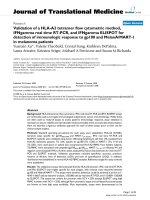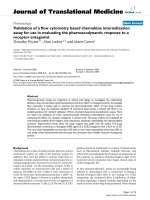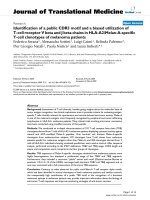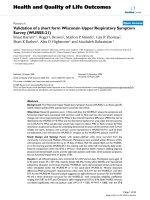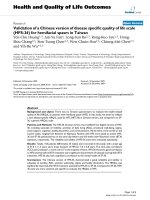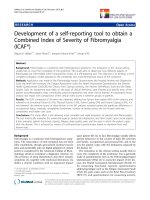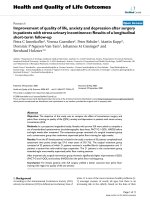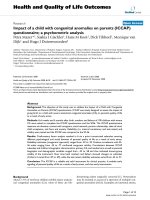báo cáo hóa học: " Improvement of quality of life, anxiety and depression after surgery in patients with stress urinary incontinence: Results of a longitudinal short-term follow-up" docx
Bạn đang xem bản rút gọn của tài liệu. Xem và tải ngay bản đầy đủ của tài liệu tại đây (298.31 KB, 11 trang )
BioMed Central
Page 1 of 11
(page number not for citation purposes)
Health and Quality of Life Outcomes
Open Access
Research
Improvement of quality of life, anxiety and depression after surgery
in patients with stress urinary incontinence: Results of a longitudinal
short-term follow-up
Petra C Innerkofler
1
, Verena Guenther
2
, Peter Rehder
1
, Martin Kopp
2
,
Dominic P Nguyen-Van-Tam
3
, Johannes M Giesinger
4
and
Bernhard Holzner*
4
Address:
1
Department of Urology, Innsbruck Medical University, Anichstr.35, A-6020 Innsbruck, Austria,
2
Department of General Psychiatry,
Innsbruck Medical University, Anichstr.35, A-6020 Innsbruck, Austria,
3
Centre for Occupational and Health Psychology, Cardiff University, UK
and
4
Department of Biological Psychiatry, Innsbruck Medical University, Anichstr.35, A-6020 Innsbruck, Austria
Email: Petra C Innerkofler - ; Verena Guenther - ; Peter Rehder - ;
Martin Kopp - ; Dominic P Nguyen-Van-Tam - ; Johannes M Giesinger - ;
Bernhard Holzner* -
* Corresponding author
Abstract
Objective: The objective of this study was to compare the effect of incontinence surgery and
pelvic floor training on quality of life (QOL), anxiety and depression in patients with stress urinary
incontinence (SUI).
Methods: In a prospective longitudinal study, females with proven SUI were asked to complete a
set of standardized questionnaires (sociodemographic data sheet, FACT-G, I-QOL, HADS) before
and eight weeks after treatment. The comparison groups consisted of a surgical treatment group
and a conservative group that underwent supervised pelvic floor training for eight weeks.
Results: From the 67 female patients included in the study a number of 53 patients completed both
assessment time points (mean age 57.4, mean years of SUI 7.6). The surgical treatment group
consisted of 32 patients of which 21 patients received a modified Burch colposuspension and 11
patients a tension-free mid-urethral tape suspension. The 21 patients in the conservative group
attended eight once-weekly supervised pelvic floor training sessions.
After treatment the surgical intervention group showed a significantly higher improvement of QOL
(FACT-G and I-QOL) and anxiety (HADS) than the pelvic floor training group.
Conclusion: For female patients with SUI surgery yielded a better outcome than pelvic floor
training with regard to quality of life and anxiety.
1. Background
According to the International Continence Society (ICS)
urinary incontinence (UI) is defined as involuntary loss of
urine. It is one of the most common health problems [1-
7] amongst women of nearly all ages, but there is an
increasing risk in the elderly. Based on the data of their
Published: 29 September 2008
Health and Quality of Life Outcomes 2008, 6:72 doi:10.1186/1477-7525-6-72
Received: 28 May 2008
Accepted: 29 September 2008
This article is available from: />© 2008 Innerkofler et al; licensee BioMed Central Ltd.
This is an Open Access article distributed under the terms of the Creative Commons Attribution License ( />),
which permits unrestricted use, distribution, and reproduction in any medium, provided the original work is properly cited.
Health and Quality of Life Outcomes 2008, 6:72 />Page 2 of 11
(page number not for citation purposes)
large-scale study Temml et al. [5] estimated that approxi-
mately 1 million people in Austria suffer from UI, 850
000 of these are women.
There are different types of UI including stress urinary
incontinence (SUI), urge incontinence, mixed inconti-
nence, neurogenic incontinence, functional incontinence
or overflow incontinence [8]. This study is restricted to
patients with SUI.
The majority of patients suffering from UI have weakened
pelvic floor muscles. In the case of SUI an increase in
intraabdominal pressure (induced by activities such as
coughing, laughing, sneezing, lifting of heavy loads or
using stairs) causes involuntary urinary leakage without
contraction of the bladder muscles [2,9,10]. SUI often
occurs when this is combined with a change of position of
the bladder with increasing intraabdominal pressure such
that the muscles that force the urethra to shut are pre-
vented from squeezing as tightly as they should. As a
result, urine may leak during moments of physical exer-
cise. SUI also occurs if the sphincter muscles weaken, e.g.
after childbirth, after pelvic floor muscles disorders or fol-
lowing anatomical changes such as after pelvic opera-
tions. Because of this dislocation of bladder and bladder
neck the increasing abdominal pressure cannot be trans-
mitted to the urethra and it therefore bears on the bladder
giving rise to involuntary leakage of urine [11,12]. In
addition the lack of oestrogen after menopause also plays
an accessory role by causing morphological and func-
tional change in the urogenital tract of women [13].
Many studies show that urinary incontinence has a nega-
tive impact on the lifestyle of the patients and affects emo-
tional, social, physical and sexual aspects of well-being
[3,6]. Incontinent women often avoid social contact
because of feelings of shame, which negatively influences
their quality of life (QOL). Incontinence sufferers may
also experience anxiety arising from concerns about
whether they will reach the toilet in time. This may lead
patients to abstain from all sorts of social activities, such
as visiting friends, sport, shopping or going to work [6].
Furthermore an association has been found between
higher levels of anxiety [14,15] and depressive symptoms
in women with urinary incontinence [16-20]. Nygaard et
al. [19] showed in their study, that patients who suffer
from UI have a smaller social network and take part in
fewer public activities, which could contribute to the
development of depressive symptoms. Fultz and Herzog
[17] found that the involuntary loss of urine leads to
despair and inferiority feelings. Furthermore patients have
reported lack of self-confidence and being left alone with
their problems as well as shame and loss of vitality [4].
The treatment of SUI should start when it becomes a cause
of concern to the patient. Before surgical treatment is con-
sidered, conservative treatment, such as pelvic floor train-
ing is recommended [21]. Studies show that pelvic floor
muscle exercises with biofeedback and electrical stimula-
tion are an effective treatment of female SUI, even in the
long term [22]. However, it has also been shown, that a
high percentage (31 – 47%) underwent incontinence sur-
gery during the following year because of persistent symp-
toms [23]. If pelvic floor training is not successful,
incontinence surgery such as the modified Burch colpo-
suspension, retropubic tension-free vaginal tape (TVT
®
) or
transobturator urethral tape suspension can be considered
[21]. The Burch colposuspension involves fastening the
lateral vaginal wall to Coopers' ligament in a tension free
fashion. The suspended anterior vaginal wall functions as
a hammock [24]. Mid-urethral tape suspension with the
new techniques (TVT
®
, SPARC
®
; MONARC
®
) fixes the ure-
thra, especially in moments of increased intra-abdominal
pressure [25].
The literature shows, that, in spite of the high prevalence
and negative consequences of UI, only a low percentage of
women seek treatment [4,5,26-28]. In this context many
researchers emphasize that many patients have a lack of
information concerning incontinence and its treatment
options [5,26].
Up to present only a few studies have investigated QOL
after incontinence surgery. These have generally shown
that the symptoms in most patients were reduced after
treatment which lead to an increase of different aspects of
well-being [29-31]. Kulseng-Hanssen et al. [29] showed,
that 5 to 10 years after a Burch colposuspension 75% of
the patients were continent during the 24 h-pad-test and
a stress test and that concern increased with symptom
intensity. Most previous studies used quantity of leaking
urine as an objective clinical outcome, whereas this study
focuses on important psychosocial variables.
2. Methods
2.1 Purpose of the study
The main objective of this longitudinal study was to eval-
uate the impact of surgery and pelvic floor training on
anxiety, depression and various aspects of QOL.
The following questions and hypotheses were addressed
in detail:
1.) Is surgical treatment superior to pelvic floor training in
patients with clinically proven SUI with regard to QOL?
Hypothesis: Patients undergoing surgery show higher
improvement in QOL-scores at 8-week-follow-up with
Health and Quality of Life Outcomes 2008, 6:72 />Page 3 of 11
(page number not for citation purposes)
regard to the FACT-G and I-QOL than patients with pelvic
floor training.
2.) Is surgical treatment superior to pelvic floor training in
patients with clinically proven SUI with regard to anxiety
and depression?
Hypothesis: Patients undergoing surgery show higher
improvement in anxiety- and depression-scores at 8-week-
follow-up with regard to the HADS than patients with pel-
vic floor training.
3.) Are disease-specific QOL- instruments more sensitive
towards improvement or deterioration over time than
generic ones?
Hypothesis: Effect sizes for changes of QOL-scores over
time are larger for the disease-specific I-QOL than for the
generic FACT-G.
2.2 Sample
In the presented non-randomized study, female patients
with diagnosed SUI attending the outpatient unit of the
Departments of Urology and Gynecology at Innsbruck
Medical University and the Department of Urology at Hall
County Hospital were consecutively included over a
period of one year. The inclusion criteria were: informed
consent, clinical diagnosis of SUI, age over 18 years and
fluency in German. Exclusion criteria were the presence of
urological or gynecological cancer and cognitive impair-
ments.
The patients were allocated to the surgical group, if they
underwent surgical treatment like the modified Burch col-
posuspension (i.e. lateral tension-free vaginal suspen-
sion), tension-free-vaginal-tape (TVT), SPARC or
MONARC. The conservative group included patients that
were on the so-called "waiting list" for surgery. They took
part in eight once-weekly training sessions to strenghten
their pelvic floor muscles. Supervision was done by a spe-
cialized pelvic floor physiotherapist. Treatment included
an initial bimanual pelvic floor muscle evaluation, indi-
vidual biofeedback training and group sessions at least
one hour at a time.
All patients received instructions for pelvic floor muscle
training on their first consultation for UI. For at least 6
weeks all patients tried pelvic floor muscle training at
home, before a decision for surgery was made.
The study used a longitudinal design comprising two
assessment time points. The patients were asked to answer
a set of questionnaires before treatment and then 8 weeks
after surgery or after completion of eight once-weekly pel-
vic floor training sessions. The study design is detailed in
the flow chart presented in Figure 1.
All subjects filled in a data sheet which recorded sociode-
mographic data, a generic QOL questionnaire, the Func-
tional Assessment of Cancer Therapy Scale – General
(FACT-G), a stress incontinence specific assessment
instrument, the Incontinence Quality of Life Instrument
(I-QOL) and the Hospital Anxiety and Depression Scale
(HADS). Clinical data were recorded from the medical
charts.
2.3 Assessment instruments
Functional Assessment of Cancer Therapy Scale – General (FACT-G)
The FACT-G (version 4) is the core questionnaire of a col-
lection of QOL inventories focusing on chronic illnesses
[32]. It is used internationally and has undergone exten-
sive psychometric testing. The FACT-G is designed for self-
assessment and consists of 27 items to be rated on a five-
point-Likert scale. Each question of the inventory is scored
from 0 (worst possible QOL) to 4 (best possible QOL). In
addition to an overall QOL score (the sum of all items),
there are subscales for the domains of physical well-being,
social well-being, emotional well-being and functional
well-being.
Incontinence Quality of Life Instrument (I-QOL)
The Incontinence Quality of Life Instrument (I-QOL) [33]
is a self-report QOL measure for evaluating the perceived
impact of UI on health-related QOL. The 22 items of the
I-QOL are answered on a five-point-Likert scale. Example
Flow-chart for study designFigure 1
Flow-chart for study design.
Allocation to the study arms
Incontinence surgery
(intervention group)
Pelvic floor training for 8
weeks (control group)
8-week-follow-up assessment: FACT-G, I-QOL, HADS
Pre-treatment: 6 weeks pelvic floor training (total sample)
Baseline assessment: FACT-G, I-QOL, HADS
Health and Quality of Life Outcomes 2008, 6:72 />Page 4 of 11
(page number not for citation purposes)
items are "I worry about not being able to get to the toilet
on time", "I worry about coughing and sneezing" and "I
have to be careful about standing up after sitting down".
Item scores are summed to produce an overall total score.
A higher score represents better QOL. The I-QOL contains
3 subscales: Avoidance and limiting behaviour (8 items),
Psychosocial impacts (9 items) and Social embarrassment
(5 items). The overall I-QOL summary score showed high
internal consistency (Cronbach's alpha 0.95) and high
retest-reliability (0.91). Each subscale also showed accept-
able alpha values (0.87–0.93) [33].
Hospital Anxiety and Depression Scale (HADS)
The Hospital Anxiety and Depression Scale (HADS) [34]
is a widely used self-rating scale for detecting anxiety and
depression and has been shown to have good psychomet-
ric properties [35,36]. The anxiety (HADS-A) and depres-
sion (HADS-D) subscales consist each of 7 items (scores
ranging 0–21). The subscales have also been shown to be
valid measures of severity of emotional disorders in clini-
cal populations with physical comorbidities [37].
2.4 Statistical methods
Subscores of the questionnaires (FACT-G, I-QOL, HADS)
were calculated according to the instructions of the devel-
opers [32-34].
A general linear model (GLM) for repeated measures was
used to investigate the long-term effect of surgical treat-
ment and pelvic floor training on anxiety, depression and
the assessed aspects of quality of life. Assessment time
points (before and 8 weeks after treatment) were included
as within-subject factor and treatment (surgical treatment
vs. pelvic floor training) as between-subject factor. The
various employed scales were used as dependent variables
each at a time. Thus the model was capable of testing dif-
ferences of the impact of treatment, overall changes in
time and treatment-independent group differences. To
determine effect sizes partial Eta squared (
p
2
) were calcu-
lated. Partial Eta squared specifies what proportion of the
sum of error variance and a certain effect variance is
explained by this effect in the sample:
p
2
= SS
effect
/(SS
effect
+
SS
error
)
Additionally T-tests for dependent and independent sam-
ples were used.
For comparisons regarding sociodemographic and clinical
variables Pearson-χ
2
-tests, Mann-Whitney-U-tests and T-
tests were conducted.
4. Results
4.1 Patient characteristics
Within the study time frame of one year a number of 67
patients met inclusion criteria and were therefore eligible
for participation in the study. All of them (100%) signed
informed consent.
Of these 33 patients (49.3%) were allocated to the surgical
treatment group and 34 patients were assigned to the pel-
vic floor training group.
One patient from the surgical treatment group and 13
patients from the pelvic floor training group dropped out
of the study before the second assessment time point. The
latter patients gave lack of time as the main reason for fail-
ing to complete the training sessions. No significant dif-
ferences with regard to sociodemographic and clinical
variables as well as all assessment instruments used were
found between patients who dropped out and those who
finished the study. Thus, 53 patients were available for sta-
tistical analyses.
In the surgical treatment group 21 patients (65.6%) were
treated with the modified Burch colposuspension and 11
patients (34.4%) with a tape suspension. The mean age
for the whole sample was 57.4 years (SD 9.4) and average
time since initial diagnosis was 7.6 years (SD 8.2)
A number of 10 patients (18.9%) had previous UI surgery
and 25 patients (47.2%) had a hysterectomy. The average
number of child births per patient was 2.3 (SD 1.1).
Besides menopausal status (χ
2
= 10.40, p = 0.01) there
were no statistically significant differences between the
surgical treatment group and the pelvic floor training
group regarding the assessed sociodemographic and clin-
ical data. Differences in age and the frequency of episiot-
omy just failed significiance (each p = 0.06). For a detailed
description of the sociodemographic and clinical data see
Table 1.
4.2 Anxiety and depression in patients undergoing surgical
treatment or pelvic floor training
There were no statistically significant differences in anxi-
ety and depression measured with HADS between the sur-
gical treatment group and the pelvic floor training group
at baseline. In the pelvic floor trainnig group differences
in anxiety and depression between baseline and 8-weeks-
follow-up were not signficant, whereas both scales dif-
fered significantly between the two assessment time
points in the surgical treatment group.
The change in depression over time did not differ signifi-
cantly between the two groups. The Anxiety-scale however
showed a significantly stronger decrease in the surgical
Health and Quality of Life Outcomes 2008, 6:72 />Page 5 of 11
(page number not for citation purposes)
treatment group than in the pelvic floor training goup (see
Table 2, Table 3 and Figure 2).
Adding menopausal status as a between-subject factor to
the GLM also did not affect the results for anxiety and
depression (not shown).
4.3 QOL in patients undergoing surgical treatment or
pelvic floor training
At baseline no statistically significant differences regard-
ing QOL were found between the surgical treatment group
and the pelvic floor training group with the exception of
FACT-G Social Well-being (surgical treatment: mean =
16.7 vs. pelvic floor training: mean = 12.7; p = 0.002).
Table 1: Sociodemographic and clinical data
Surgery
(N = 32)
Pelvic floor training
(N = 21)
Total
(N = 53)
Age mean (SD) 59.8 (9.2) 54.5 (9.0) 57.4 (9.4) t = 1.96, p = 0.06
range 37 – 78 38 – 68 37 – 78
Marital status unmarried/single 9.4% 0.0% 5.7% χ
2
= 3.69, p = 0.30
married/partnership 78.1% 90.5% 83.0%
divorced/separated 6.3% 0.0% 3.8%
widowed 6.3% 9.5% 7.5%
Education primary school 40.6% 33.3% 37.7% χ
2
= 1.74, p = 0.63
completed apprenticeship 46.9% 61.9% 52.8%
A-level/university 12.5% 4.8% 9.4%
Occupational status full time work 9.4% 9.5% 9.4% χ
2
= 7.18, p = 0.07
part time work 15.6% 38.1% 24.5%
housewife 15.6% 28.6% 20.8%
retired 59.4% 23.8% 45.3%
Years of urinary stress incontinence mean (SD) 7.2 (7.8) 8.3 (8.8) 7.6 (8.2) Z = 0.63, p = 0.53
range 0.2 – 31.0 2.0 – 38.0 0.2 – 38.0
Number of births mean (SD) 2.3 (1.2) 2.2 (1.1) 2.3 (1.1) Z = -0.21, p = 0.83
0 3.1% 0.0% 1.9%
1 18.8% 19.0% 18.9%
2 46.9% 52.4% 49.1%
≥ 3 31.2% 28.6% 30.1%
Episiotomy yes 40.6% 66.7% 50.9% χ
2
= 3.44, p = 0.06
no 59.4% 33.3% 49.1%
Caesarian section yes 6.3% 0.0% 3.8% χ
2
= 1.36, p = 0.24
no 93.8% 100.0% 96.2%
Birth weight of the heaviest child mean (SD) 3485 (468) 3620 (494) 3540 (479) t = -0.99, p = 0.33
< 3000 g 10.0% 9.5% 9.8%
3000 – 3999 73.3% 61.9% 68.6%
≥ 4000 16.7% 28.6% 21.6%
Body Mass Index mean (SD) 26.6 (4.2) 27.1 (5.9) 26.8 (5.0) Z = -0.19, p = 0.85
range 19.5–39.4 20.8–47.0 19.5–47.0
Menopausal status before menopause 9.4% 28.6% 17.0% χ
2
= 10.40, p = 0.01
in menopause 21.9% 47.6% 32.1%
after menopause 68.8% 23.8% 50.9%
Psycholog./psychiatric treatment yes 15.6% 9.5% 13.2% χ
2
= 0.41, p = 0.52
no 84.4% 90.5% 86.8%
Health and Quality of Life Outcomes 2008, 6:72 />Page 6 of 11
(page number not for citation purposes)
Increase in QOL between baseline and 8-weeks-follow-up
reached significance (p < 0.05) for all FACT-G and I-QOL
scales in the surgical treatment group. In the pelvic floor
training group only the I-QOL-scale Avoidance had a sig-
nificant increase (p = 0.045). The GLM for repeated meas-
ures showed that the FACT-G scales Emotional Well-
being, Functional Well-being and Total-Score showed a
significantly higher improvement over time in the surgical
treatment group than in the pelvic floor training group
(see Table 2, Table 3 and Figure 3).
Furthermore, there were significantly higher increases in
the surgical treatment group regarding the I-QOL-scales
Table 2: Descriptive statistics for anxiety and depression (HADS*) and quality of life (FACT- G** and I-QOL**)
Baseline 8-weeks
Surgical treatment Pelvic floor
training
Surgical treatment Pelvic floor
training
Mean (SD) Mean (SD) Mean (SD) Mean (SD)
HADS
Anxiety 5.0 (3.5) 5.4 (2.7) t = -0.50; p = 0.619 2.6 (2.4) 4.7 (3.1) t = -2.74; p = 0.008
Depression 4.1 (3.6) 4.2 (2.7) t = -0.11; p = 0.917 2.3 (3.5) 4.2 (3.2) t = -2.00; p = 0.046
FACT-G
Physical well-being 23.0 (5.9) 24.9 (3.8) t = -1.31; p = 0.196 25.2 (3.7) 25.4 (2.6) t = -0.28; p = 0.784
Emotional well-
being
19.2 (3.6) 18.2 (3.7) t = 0.92; p = 0.363 21.6 (2.8) 18.3 (3.3) t = 3.88; p < 0.001
Functional well-
being
20.3 (6.0) 20.3 (3.7) t = 0.04; p = 0.965 23.0 (4.7) 20.5 (3.7) t = 2.05; p = 0.046
Social well-being 16.7 (5.4) 12.7 (3.5) t = 3.21; p = 0.002 18.3 (4.3) 14.5 (5.5) t = 2.82; p = 0.007
Total 79.2 (15.6) 76.0 (9.2) t = 0.92; p = 0.360 88.1 (12.1) 78.7 (10.1) t = 2.89; p = 0.006
I-QOL
Avoidance 24.8 (7.6) 26.1 (6.7) t = -0.66; p = 0.511 36.5 (4.6) 28.7 (6.5) t = 4.74; p < 0.001
Psychosocial
impact
33.9 (7.8) 37.4 (5.7) t = -1.78; p = 0.081 42.9 (3.1) 38.7 (6.2) t = 2.89; p = 0.008
Social
embarrassment
13.8 (5.9) 16.7 (4.9) t = -1.84; p = 0.072 23.7 (2.5) 18.3 (4.6) t = 4.89; p < 0.001
Total 72.5 (18.2) 80.2 (15.7) t = -1.59; p = 0.117 103.1 (9.2) 85.7 (16.5) t = 4.41; p < 0.001
* higher scores indicates more anxiety and depression
** higher value indicates better quality of life
Table 3: Group, time and interaction effects from the general linear model for repeated measures for anxiety and depression (HADS)
and quality of life (FACT- G and I-QOL)
Group Time Group-time-interaction
Fp
p
2
Fp
p
2
Fp
p
2
HADS
Anxiety 2.84 0.098 0.053 16.78 < 0.001 0.248 4.85 0.032 0.087
Depression 1.64 0.206 0.031 3.47 0.068 0.064 3.47 0.068 0.064
FACT-G
Physical Well-being 0.90 0.346 0.017 9.372 0.004 0.155 3.32 0.074 0.061
Emotional Well-being 7.50 0.008 0.128 5.53 0.023 0.098 4.73 0.034 0.085
Functional Well-being 1.02 0.318 0.020 9.45 0.003 0.157 7.09 0.010 0.122
Social Well-being 10.17 0.002 0.169 8.34 0.006 0.143 0.01 0.913 > 0.001
Total 3.55 0.065 0.066 21.12 < 0.001 0.297 5.99 0.018 0.107
I-QOL
Avoidance 4.68 0.035 0.084 50.82 < 0.001 0.499 50.52 < 0.001 0.287
Psychosocial Impact 0.06 0.805 0.001 27.76 < 0.001 0.352 15.62 < 0.001 0.234
Social Embarrassment 1.47 0.23 0.028 56.79 < 0.001 0.527 29.30 < 0.001 0.365
Total 1.93 0.171 0.036 56.07 < 0.001 0.524 27.03 < 0.001 0.346
Health and Quality of Life Outcomes 2008, 6:72 />Page 7 of 11
(page number not for citation purposes)
Avoidance, Psychosocial-Impact, Social Embarrassment
and Total-Score (see Table 2, Table 3 and Figure 4).
Adding menopausal status as a between-subject factor to
the GLM did not affect the results for QOL (not shown).
The intervention effect sizes were about four times bigger
for the aspects of QOL that were covered by the I-QOL
than for those assessed by the FACT-G (average
p
2
= 0.308
vs. 0.075).
5. Discussion
It is well known that UI influences emotional, social and
physical aspects of well-being and has a negative impact
on the patients' QOL [3,6].
Surgical treatment is considered when conservative treat-
ment (in particular pelvic floor training) is ineffective.
Studies regarding this topic have primarily focused on
clinical parameters such as leaking of urine. In contrast
psychological outcome variables (i.e. psychological well-
being) have usually been regarded as being only of sec-
ondary importance.
The aim of this longitudinal study was to compare surgical
treatment and pelvic floor training in patients with clini-
cally proven SUI with regard to QOL, anxiety and depres-
sion. The main focus was the effect of surgery and pelvic
floor training on the course of patients' subjective well-
being.
At baseline (apart from social well-being) no relevant dif-
ferences were found for QOL anxiety and depression
between the surgery group and the pelvic floor training
group.
The FACT-G Social Well-being scale comprises mainly
items regarding social support rather than participation in
social acitivities. The finding that at baseline patients in
the surgical treatment group had higher scores on the
dimension of social well-being may be because, as Swith-
inbank et al. [6] and Berglund et al. [7] have suggested,
incontinence is a taboo subject and incontinent women
have difficulty talking about it, especially to their hus-
bands. It can be assumed that because surgery necessitates
a hospitalisation, a lot of patients were forced to inform
their families about their disease. This may have increased
acceptance of the disease and received social support.
As expected the general FACT-G scales were less sensitive
towards changes in QOL over time than the disease-spe-
cific I-QOL scales. This resulted in considerably smaller
effect sizes for the FACT-G scales, i.e. a smaller proportion
of explained variance compared with error variance.
Since the FACT-G Physical Well-being scale covers a more
severe range of physical impairment than usually found in
patients with SUI, a strong ceiling effect occured and no
significant difference between the two treatment groups
was shown.
For Emotional Well-being, Functional Well-being and
global QOL however the surgical treatment group showed
a significantly higher improvement over time than the
pelvic floor training group.
Changes in anxiety and depression (HADS)Figure 2
Changes in anxiety and depression (HADS).
Assessment
8 weeksBaseline
Estimated Marginal Means
6,00
5,00
4,00
3,00
2,00
Pelvic floor
training group
Surgical
treatment group
HADS-Anxiety
Assessment
8 weeksBaseline
Estimated Marginal Means
6,00
5,00
4,00
3,00
2,00
Pelvic floor
training group
Surgical
treatment group
HADS-Depression
Health and Quality of Life Outcomes 2008, 6:72 />Page 8 of 11
(page number not for citation purposes)
Changes in physical well-being (FACT-PWB), emotional well-being (FACT-EWB), functional well-being (FACT-FWB), social well-being (FACT-SWB) and FACT-TotalFigure 3
Changes in physical well-being (FACT-PWB), emotional well-being (FACT-EWB), functional well-being
(FACT-FWB), social well-being (FACT-SWB) and FACT-Total.
Assessment
8 weeksBaseline
Estimated Marginal Means
28,00
26,00
24,00
22,00
Pelvic floor
training group
Surgical
treatment group
FACT-PWB
Assessment
8 weeksBaseline
Estimated Marginal Means
24,00
22,00
20,00
18,00
Pelvic floor
training group
Surgical
treatment group
FACT-EWB
Assessment
8 weeksBaseline
Estimated Marginal Means
24,00
22,00
20,00
18,00
Pelvic floor
training group
Surgical
treatment group
FACT-FWB
Assessment
8 weeksBaseline
Estimated Marginal Means
20,00
18,00
16,00
14,00
12,00
Pelvic floor
training group
Surgical
treatment group
FACT-SWB
Assessment
8 weeksBaseline
Estimated Marginal Means
90,00
88,00
86,00
84,00
82,00
80,00
78,00
76,00
Pelvic floor
training group
Surgical
treatment group
FACT-Total
Health and Quality of Life Outcomes 2008, 6:72 />Page 9 of 11
(page number not for citation purposes)
Regarding the I-QOL the surgical treatment group yielded
a significantly better outcome for all scales (Avoidance
and Limiting Bevahior, Psychosocial Impact, Social
Embarrassment and I-QOL-Total).
All patients had relevant problems regarding Psychosocial
Impact before treatment such that, one way or the other,
all patients became socially withdrawn and for example
avoided having to meet in public places or at public
events. These results are acknowledged by Swithinbank et
al. [6]. According to their study incontinence may cause
withdrawal from social activities and the women with
incontinence have less social interaction than women
without involuntary loss of urine. Similar results from
Berglund et al. [7] describe diminished social integration
and loneliness as a result of it. This may contribute to the
development of anxiety or depressive symptoms and
reduce global QOL.
The results with regard to the dimension of Social Embar-
rassment were similar to those of Psychosocial Impact.
Before treatment many women described their experience
with incontinence as embarrassing and so often stayed at
home because they were anxious about not having ready
access to a toilet and were fearful of an urinary accident in
public. In this context Bogner et al. [38] describe the loss
of self-confidence caused by the feeling of shame. This can
also cause a further withdrawal from social activities.
Changes in avoidance and limiting behavior (I-QOL-VE), psychosocial impact (I-QOL-PS), social embarrassment (I-QOL-SE) and I-QOL-TotalFigure 4
Changes in avoidance and limiting behavior (I-QOL-VE), psychosocial impact (I-QOL-PS), social embarrass-
ment (I-QOL-SE) and I-QOL-Total.
Assessment
8 weeksBaseline
Estimated Marginal Means
40,00
35,00
30,00
25,00
20,00
Pelvic floor
training group
Surgical
treatment group
I-QOL-VE
Assessment
8 weeksBaseline
Estimated Marginal Means
50,00
45,00
40,00
35,00
30,00
Pelvic floor
training group
Surgical
treatment group
I-QOL-PS
Assessment
8 weeksBaseline
Estimated Marginal Means
30,00
25,00
20,00
15,00
10,00
Pelvic floor
training group
Surgical
treatment group
I-QOL-SE
Assessment
8 weeksBaseline
Estimated Marginal Means
110,00
100,00
90,00
80,00
70,00
Pelvic floor
training group
Surgical
treatment group
I-QOL-Total
Health and Quality of Life Outcomes 2008, 6:72 />Page 10 of 11
(page number not for citation purposes)
After incontinence surgery patients also had a significantly
better outcome for Avoidance and Limiting Behaviour
than the conservative group. Before surgical treatment
patients often worried, if they did not know where the toi-
lets were, that they had to plan every detail in advance
because of their UI and that they were afraid of physical
activities, because of the association between involuntary
loss of urine and physical strain. The outcome of these
limitations is once more social retreat and in worst case
social isolation of the patient (according to Bogner et al.
[38] this limiting of social and physical activities is "con-
dition-specific functional loss"). This may be self-
imposed by the patients to help managing their condi-
tion, but it may lead to feelings of loss of control and dis-
tress and it diminishes life satisfaction.
Thus the results from the I-QOL scales and the FACT-G
scales are concordant since decreased social withdrawal
and avoidance, reduced psychosocial impact and less
embarrassment are accompanied by better emotional and
functional well-being.
Not assessed in our study but nevertheless of importance
is the negative impact of SUI on women's sexual function-
ing and sexual well-being. As Oh et al. [39] pointed out a
relevant proportion of women suffering from SUI reports
pain during intercourse and coital incontinence, that have
a detrimental effect on overall well-being.
Another aim of the study was to determine whether the
effect of surgical treatment or pelvic floor training differs
regarding anxiety and depression. Improvement regarding
anxiety was significantly higher in the surgical treatment
group than in the pelvic floor training group, whereas dif-
ferences in changes for depression failed significance.
To compare anxiety and depression in this sample of
women suffering from SUI with age-matched women in
the general population we used reference data from Hinz
and Schwarz [40]. Their study provides norm values for
the HADS from a representative sample of the German
adult population (n = 2037). For women aged 40–59 they
report for the HADS anxiety scale a mean value of 5.2 (SD
3.4) and for depression a mean value of 4.8 (SD 3.7).
These scores are very similar to those found for the pelvic
floor training group at baseline and after treatment and
for the surgical treatment group at baseline. Eight weeks
after treatment however the surgical treatment group
showed notably lower average scores regarding anxiety
(2.6) and depression (2.3).
The findings of our study concerning depression are
somewhat different to other studies, e.g. Steers et al. [16]
and Fultz et al. [17] reported heightened values of depres-
sion in patients with urinary incontinence. Depression
would also seem to be consistent with negative emotions
and feeling of inferiority caused by involuntary loss of
urine.
Some limitations of the study should be mentioned. The
exact degree of SUI (i.e. pad test) was not investigated.
Thus, it cannot be evaluated, if a higher degree of UI
causes a higher degree of psychological burden to the
patients. The main focus of treatment, however, was the
subjective feelings of the patient and for this reason ques-
tionnaires as self-rating instruments were used. Further-
more, it is noted that to achieve maximum efficacy, pelvic
floor training requires daily training in addition to the
once-weekly training sessions. The extent of patient com-
pliance with this additional daily training is unknown.
Lack of compliance with the once-weekly training can be
seen as the reason for not completing the 8-weekly pelvic
floor training sessions in 13 patients. On the other hand
the problem of limited compliance not only occurs in this
study sample but is a general drawback of pelvic floor
training.
A further limitation is that the follow-up-assessment took
place only eight weeks post-operatively. In view of the fact
that the healing process after surgery takes months, it can
be expected, that the QOL of the patients will even
improve further. Nevertheless it has to be pointed out,
that the long-term effect of surgery is again dependent on
the strength and functional activity of the pelvic floor
muscles.
Finally, comparability of the surgical treatment group and
the pelvic floor training group might be affected by
unknown confounders since for ethical reasons randomi-
zation was not possible.
In spite of the favourable outcome of the surgical treat-
ment procedure in this study, we are aware of the fact, that
it should never be forgotten that surgery always contains
risks for the patients. According to Broome [21] pelvic
floor training could be considered as part of conservative
first-line therapy. Taking into account the natural progres-
sion of the disease appropriately scheduled follow-up
examinations may be the basis for initiating surgery.
6. Conclusion
In summary, for SUI patients eight weeks after treatment,
surgery (modified Burch colposuspension, tension-free
mid-urethral tape suspension) yielded a better outcome
with regard to QOL and anxiety than pelvic floor training.
Longterm follow-up is planned to determine whether this
difference is still present one year after treatment.
Competing interests
The authors declare that they have no competing interests.
Health and Quality of Life Outcomes 2008, 6:72 />Page 11 of 11
(page number not for citation purposes)
Authors' contributions
IP and GV were responsible for study design and concep-
tualization as well as for data collection. RP was one of the
treating urologists and therefore in charge of patient
recruitment. GJ and KM performed the statistical analysis.
HB and ND helped to draft the manuscript and gave
important input for intellecutal content.
Acknowledgements
We want to thank Georg Kemmler for statistical advice and critical reading
of the manuscript.
References
1. Nancy H, Fultz P, Herzog R: Self-Reported Social and Emotional
Impact of Urinary Incontinence. Am Ger Soc 2001, 49:892-899.
2. Vapnek J: Screening and treatment of urinary dysfunction.
Geriatrics 2001, 56(10):25-29.
3. Lalos O: Impact of urinary and climacteric symptoms on
social and sexual life after surgical treatment of stress uri-
nary incontinence in women: a long-term outcome. J
Advances Nursing 2001, 33(3):316-327.
4. Shaw C: A review of the psychosocial predictors of help-seek-
ing behaviour and impact on quality of life in people with uri-
nary incontinence. Journal of Clinical Nursing 2001, 10:15-24.
5. Temml C, Haidinger G, Schmidbauer J, Schatzl G, Madersbacher S:
Urinary Incontinence in Both Sexes: Prevalence Rates and
Impact on Quality of Life and Sexual Life. Neurourol Urodynam
2000, 19:259-271.
6. Swithinbank L, Abrams P: The impact of urinary incontinence on
the quality of life of women. World J Urol 1999, 17:225-229.
7. Berglund A, Eisemann M, Lalos A, Lalos O: Social adjustment and
spouse relationships among women with stress incontinence
before and after surgical treatment. Soc Sci Med 1996,
42(11):1537-1544.
8. Abrams P, Cardozo L, Fall M, Griffith D, Rosier P, Ulmsten U, Kerre-
broeck P, Victor A, Wein A: The standardisation of terminology
in lower urinary tract function: report from the standardisa-
tion sub-committee of the International Continence Society.
Urology 2003, 61(1):37-49.
9. Petros P, Ulmsten U: An anatomical classification – a new par-
adigm for management of female lower urinary tract dys-
function. Eur J Obst Gyn 1998, 80:87-94.
10. Giannantoni A, Di Stasi S, Cucchi A, Mearini E, Bini V, Porena M: Pel-
vic Floor Muscle Behaviour During Valsalva Leak Point Pres-
sure Measurement in Males and Females Affected by Stress
Urinary Incontinence. J Urol 2003, 170(2 Pt 1):485-489.
11. Bump R, Mattiasson A, Bo K, Brubaker L, Delancey J, Klarsov P: The
Standardisation of Terminology of Female Pelvic Organ
Prolapse and Pelvic Floor Dysfunction. Am J Obst Gynecol 1996,
175:10-11.
12. Delancey J, Ashton-Miller J: Pathophysiology of adult urinary
incontinence. Gastroenterology 2004, 126(1):23-32.
13. Goes V, Sartori M, Baracat E, Rodrigues de Lima G, Girao M: Urody-
namic and clinical evaluation of postmenopausal women
with stress urinary incontinence before and after cyclic
estrogen therapy. Clin Exp Obstet Gynecol 2003, 30:103-106.
14. Mehta K, Simonsick R, Penninx B, Schulz R, Rubin S, Satterfield S, Yaffe
K: Prevalence and Correlates of Anxiety Symptoms in Well-
Functioning Older Adults: Findings from the Health Aging
and Body Composition Study. J Am Geriatr Soc 2003, 51:499-504.
15. Watson J, Currie I, Curran S, Jarvis G: A prospective study exam-
ining the association between the symptoms of anxiety and
depression and severity of urinary incontinence. Eur J Obst Gyn
1998, 88(1):7-9.
16. Steers W, Lee L: Depression and incontinence. World J Urology
2001, 19:351-357.
17. Fultz N, Herzog R: Self-Reported Social and Emotional Impact
of Urinary Incontinence. J Am Geriatr Soc 2001, 49:892-899.
18. Bodden-Heidrich R, Beckmann M, Libera B, Rechenberger I, Bender
H: Psychosomatic aspects of urinary incontinence. Arch Gyne-
col Obst 1999, 262:151-156.
19. Nygaard I, Turvey C, Burns T, Crischilles E, Wallace R: Urinary
incontinence and depression in middle-aged United States
women. Obstet Gynecol 2003, 101:71-76.
20. Melville J, Walker E, Katon W, Wentz G, Miller J, Fenner D: Preva-
lence of comorbid psychiatric illness and its impact on symp-
tom perception, quality of life and functional status in
women with urinary incontinence. Am J Obstet Gynecol 2002,
187(1):80-87.
21. Broome B: The impact of urinary incontinence on self-efficacy
and quality of life.
Health and Quality of Life Outcomes 2003, 1:35.
22. Parkkinen A, Karjalainen E, Vartiainen M, Penttinen J: Physiotherapy
for Female Stress Urinary Incontinence: Individual Therapy
at the Outpatient Clinic Versus Home-Based Pelvic Floor
Training: A 5-Year Follow-Up Study. Neurourol Urodyn 2004,
23:643-648.
23. Aukee P, Immonen P, Laaksonen D, Laippala P, Penttinen J, Airaksinen
O: The effect of home biofeedback training on stress incon-
tinence. Acta Obstet Gynecol Scand 2004, 83:973-977.
24. Lewis R: Abdominal Repair of Female Incontinence. Urologic
Survey. Lippincott 1991:778-789.
25. Ulmsten U: The basic understanding and clinical results of ten-
sion-free vaginal tape for stress urinary incontinence. Der
Urologe 2001, 40:269-273.
26. Lin S, Dougherty M: Incontinence impact, symptom distress
and treatment-seeking behaviour in women with involun-
tary urine loss in Southern Taiwan. International Journal of Nurs-
ing Studies 2003, 40:227-234.
27. Milsom I: The prevalence of urinary incontinence. Acta Obstet
Gynecol Scandinavica 2000, 79:1056-1059.
28. Sampselle C, Harlow S, Skurnick J, Brubaker L, Bondarenko I: Uri-
nary incontinence predictors and life impact in ethnically
diverse perimenopausal women. Obstet Gynecol 2000,
100(6):1230-1238.
29. Kulseng-Hanssen S, Berild G: Subjective and Objective Inconti-
nence 5 to 10 Years after Burch Colposuspension. Neurourol
Urodynam 2002, 21:100-105.
30. Jeffry L, Deval B, Birsan A, Soriano D, Dariai E: Objective and Sub-
jective Cure Rates after Tension-Free-Vaginal-Tape for
Treatment of Urinary Incontinence. Urology 2001, 58:702-706.
31. Kammerer-Doak D, Dorin M, Rogers R, Cousin M: A randomized
trial of burch retropubic urethropexy and anterior colpor-
rhaphy for stress urinary incontinence. Obstet Gynecol 1999,
93(1):75-78.
32. Cella DF, Tulsky DS, Gray G, Sarafian B, Linn E, Bonomi A, Silberman
M, Yellen SB, Winicour P, Brannon J: The Functional Assessment
of Cancer Therapy scale: development and validation of the
general measure. J Clin Oncol 1993, 11(3):570-9.
33. Patrick D, Martin M, Bushnell D, Yalcin I, Wagner T, Buesching D:
Quality of life of women with urinary incontinence: Further
Development of the incontinence quality of life instrument
(I-QOL). Urology 1999, 53:71-76.
34. Zigmond A, Snaith R: The hospital anxiety and depression scale.
Acta Psychiatr Scand 1983, 67(6):361-370.
35. Herrmann C: International experiences with the Hospital
Anxiety and Depression Scale–a review of validation data
and clinical results. J Psychosom Res 1997, 42(1):17-41.
36. Spinhoeven P, Ormel J, Sloekers P, Kempen G, Speckens A, Van
Hemert A: A validation study of the Hospital Anxiety and
Depression Scale (HADS) in different groups of Dutch sub-
jects. Psychol Med 1997, 27:363-370.
37. Johnston M, Pollard B, Hennessey P: Construct validation of the
hospital anxiety and depression scale with clinical popula-
tions. J Psychosom Res 2000, 48(6):579-584.
38. Bogner H, Gallo J, Sammel M, Ford D, Armenian H, Eaton W: Uri-
nary Incontinence and Psychological Distress in Commu-
nity-Dwelling Older Adults. J Am Geriatr Soc 2002, 50:489-495.
39. Oh S, Ku J, Choo M, Yun J, Kim D, Park W: Health-related quality
of life and sexual function in women with stress urinary
incontinence and overactive bladder. Int J Urology 2008,
15(1):62-67.
40. Hinz A, Schwarz R: Angst und Depression in der Allgemeinbev-
ölkerung [Anxiety and depression in general population].
Psychothera Psychosom med Psychol 2001, 51:193-200.
